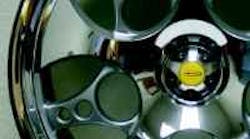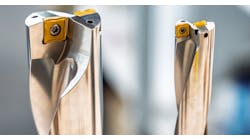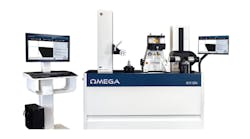Production cell gives wheelmakers what they want.
Mori Seiki's AZL 2400 turning center for wheel machining has a horizontal, twin slant-bed base supporting dual slant-V opposed turrets on either side of the spindle at 45°. The design creates an opening below the spindle for chip evacuation.
Mori Seiki's AFM 2400 drilling center features a traveling column surrounding a Z-axis ram with 23.6 in. of travel. The design provides maximum reach for large wheels and makes for effective chip evacuation.
The AZL's headstock moves out to within 16 in. of the front of the machine for easy part loading/unloading without moving tool turrets. Its chuck has fingers that clamp a wheel's outer rim flange, instead of squeezing it, for a secure hold.
Wheels load horizontally into the AFM 2400's fixture, which then tips up to a full-vertical position for complete wheel machining from all sides in one setup.
There aren't a lot of machine tools made specifically for manufacturing alloy wheels. Most of what's available are adaptations of existing equipment modified with a few extra features. Taking a different approach, a machine tool builder and one of its distributors consulted with 14 major wheelmakers to determine exactly what the industry needed. The builder then designed and built, from the ground up, equipment for machining alloy wheels.
At the top of the wheelmaker wish list was the ability to increase throughput, control and contain chips, improve part quality/tolerances, and run practically maintenance free 24/7. Armed with this knowledge and input from distributor Ellison Machinery Co., Mori Seiki developed the AZL 2400 and the AFM 2400 machines for wheel-manufacturing cells.
The AZL 2400 is a 4-axis turning center with a horizontal, twin slant bed. This special base supports dual slant-V opposed turrets located on either side of the spindle at 45°. The configuration creates an opening below the spindle for chip evacuation and a work envelope with all angled surfaces, so chips have nowhere to collect. Also, there are no hydraulic hoses, wire looms, or electrical components within the work envelope for flying chips to abrade or wear, eventually causing downtime.
Machining one low-pressure, 20-in. wheel casting generates about 11 lb of chips. On average, a wheel shop interrupts its machining process to clear chips three times per shift, and each of these interruptions lasts about 15 min, says Bill Amiguet, vice president of engineering at Ellison in Santa Fe Springs, Calif. The AZL reduces this task to just once at the end of a shift.
For a shop running three shifts, five days a week, the AZL returns a cell to 312 hours of production per year. "That's a substantial amount," adds Amiguet, "when one considers that a typical cell runs thirty-four 20-in. wheels an hour."
While the AZL's base and turrets solve chip problems, its spindle and chuck play a large role in controlling part quality. Holding tolerances and producing a true wheel depends on a machine's ability to keep in check the oscillations or imbalances produced by a 50-lb wheel casting spinning at 2,000 rpm.
The AZL has a large and long spindle. Length-to-diameter-between-bearings ratio is over 5:1, and each spindle, bearing set, and rotor assembly is precision ground and dynamically balanced to within 3 grams. All of which, says Mori Seiki, makes for a rigid spindle that is unaffected by a casting's out-of-roundness. As a result, the machine holds tolerances for roundness and wheel runout to 0.1 mm. The integral spindle motor and drive sports 100 hp — the spindle itself is the rotor, and the headstock is a stator.
Headstocks on AZLs are another axis, not one for machining, but for loading and unloading. It moves forward to within 16 in. of the machine front, giving easy access for manual or automated part loading/unloading.
Loading involves only the X axis retracting up, so turrets don't have to move out of the way. Plus, there is no need for large amounts of tool-clearance room. All tooling, both I.D. and O.D., are at the same Z-axis position and do not interfere with the chuck or its jaws. As such, shops can situate turning tools next to boring tools and vice versa.
This moving headstock makes for a shorter Z-axis ballscrew, which provides increased speed and rigidity because there is less whip. "Rapid traverse rates in the Z axis on conventional machines is usually around 800 ipm," says Amiguet. "The AZL's is 1,156 ipm."
Workholding on the AZL is a chuck made just for gripping alloy wheels. It's from Automated Specialties Inc. (ASI) in Michigan and uses fingers that maintain a wheel's shape and are less compromised by centrifugal force. The fingers clamp the wheel's outer rim flange and pull it back against solid work rests, rather than squeezing it like a 3-jaw chuck would.
AFM 2400
The AFM 2400 is a 4-axis drilling center with a 3-axis traveling column surrounding a Z-axis ram with 23.6 in. of travel. This design provides maximum reach for large wheels and lets chips freely fall away from machine slides and components. And, like the AZL, there are no hydraulic hoses, electrical looms, or exposed components in the AFM's workzone.
"Traditional horizontal-machining-center columns move in and out on the Z axis, or the table does," says Amiguet. "Chips collect between the fixture and the column, a situation magnified during wheel manufacturing. As the column moves in, it compresses chips, forcing them under covers and into other places." The AFM eliminates this problem by moving its spindle/ram to the part rather than its column or table. The column traverses only in the X and Y axes, so the space below the spindle is kept open for a trough to collect and carry off chips. In addition, vertical stainless covers protect all machine axes.
For short non-cut times, high output, and the capability to handle today's holemaking tools, the AFM's spindle packs 25 hp, runs at 100 to 12,000 rpm, and feeds 100 ipm, while the machine itself rapids at 1,600 ipm. Four sets of wide-stance linear guideways support the ram assembly, front and back, for rigid and accurate holemaking.
According to Mori Seiki, the AFM's trunnion-style workholding fixture provides both the easy loading of a vertical drilling machine and the chip evacuation of a horizontal. Wheels load horizontally into the fixture, which also tilts 45° toward the operator for easier manual loading. It then tips the wheel to a full-vertical position for complete wheel machining from all sides in one setup. In this position, chips easily fall away from wheel and don't collect inside it.
The universal fixture uses standard Speedgrip collets and accommodates wheels from 13 to 24 1 /2 in. It rotates 360° at 198°/sec (33 rpm) and hydraulically locks its rotary axis and trunnion bearing for rigidity. The center collet and four universal swing clamps also clamp hydraulically. Both the fixture's clamps and rest-pad assembly sit well above the machine base to further eliminate chip packing.
According to Amiguet, most people misjudge how punishing drilling cycles are to machine tools. This is why Mori Seiki gave the AFM a beefy structure, with combined major components, such as base, column, spindle carrier, ram, bridge, and work-holding, weighing over 22,000 lb.
For corrective and preventative maintenance, both the AFM and AZL have easy-access doors instead of large, bulky, screw-on covers. The Mori Seiki doors are a key-lock style and near vital machine components.
A prime cell
For the first cell operation at Prime Wheels, an AZL 2400 completely machines the brake side of wheels. A robot then loads them into an AFM 2400 for drilling in the second operation. Lastly, another AZL 2400 cuts the wheels' street-side surfaces.
Prime Wheels is one of the first shops to install Mori Seiki's new wheel-manufacturing equipment. The Carson, Calif., company has four cells, each doing three wheel operations and consisting of two AZL 2400s, an AFM 2400, and a Fanuc robot loader. One AZL is for the first operation, the AFM does the second operation, and the other AZL does the third operation. Since incorporating these cells, Prime has increased throughput for 20-in. wheels by 15%, and its time spent on preventative maintenance has been cut in half.
In the first cell operation, the AZL cuts the complete brake-side of the wheel. This includes brake clearance, mounting-pad surface, and center pilot bore, which fits onto the vehicle hub. Pilot bores are crucial because all the wheel tolerances and subsequent operations reference off them and the mounting surfaces. The machine also cuts the wheel O.D., which entails the tire-seat and drop areas. (The drop is the part of the wheel between the inner and outer tire seats).
This first operation, for Prime, controls cycle time. The company determines the cell's throughput by this operation's machining time, when the majority of material is removed. For 15 or 16-in.-diameter wheels, first-operation machining time is about 55 sec, and 20-in.-diameter wheels take around 90 sec.
The second operation at Prime is drilling. Wheels load into the AFM's fixture, locate off the mounting face and pilot bore, and stay in position with swing clamps. The machine drills five or six lug holes and the valve-stem hole and performs other operations, such as counterboring, on the back of the wheel.
For the third operation, an AZL identical to the one in the first operation machines wheels on the street-side. A center locator pin, which matches up to the center hub bore, accurately positions the wheel for machining. Generally, this is the shortest of the three operations, unless it involves a full-face-machined wheel.
If this is the case, Prime uses the machine's four axes to turn the face while simultaneously doing O.D. work. For shops not doing full-face-machined wheels, Mori Seiki offers an ASL 2400 two-axis machine.
In addition to machine tools, Prime's cells have in-process gaging that feeds real-time data to the machines so they can adjust to keep wheels within tolerance — all without operator intervention. Also, there are vision systems that recognize and orientate wheels properly.
A cell controller lets Prime monitor cells from a remote location via an ether-net connection. The shop manager checks if machines are running and sees current shift status for parts produced or rejected. And the controller indicates where cell idle times are.






